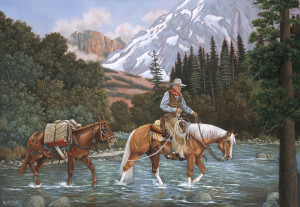 Across the High Lonesome | Many a times I wished I had been born when this country was a little wilder and a lot less populated. My wife and I had the opportunity to camp and ride in the Gros Ventre Wilderness area which is located behind the elk refuge near Jackson Hole, Wyoming. Some of the most beautiful unspoiled, country and definitely near High Lonesome. |
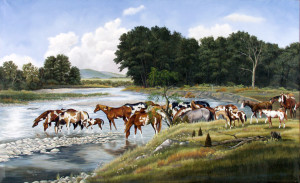 Afternoon Drink | This scene is taken from a particular place along the Jack's Forks River in the Ozark region of southern Missouri. When I was young I used to ride along this river on our family trail riding vacations. The horses in the picture are a few of the many my wife and I have raised over the past 30 years. They were painted from individual photographs we had taken. If I ever sell the farm, I might slip off to these hills with my art supplies and a good saddle horse and never come back. |
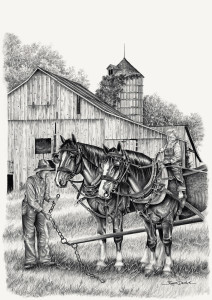 Afternoon with Grandpa | When I was little bitty, sometimes we would go to visit my Great Uncle Goetleb. He lived hidden, back behind the hills, on a Cahokia river bottom farm. Although he had an old John Deere A, he was the last one in the neighborhood to keep a team, and actually use them. He would harness them every morning and whether he used them or not, they were always ready. I remember when he let me ride one of the gentle old horses out to the field. Little things like that are never forgotten. |
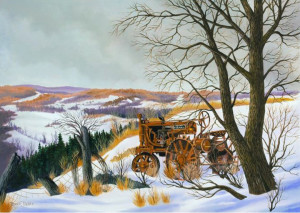 Another December | Seasons change, marking the passage of time. How many Decembers has this old tractor sat silently and unnoticed; stoically bearing witness to the time of the small family farm, as the world continues to changes around it. |
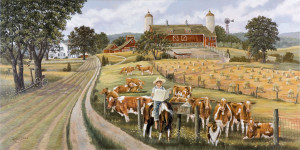 As I Remember | When I was a young boy, I used to practically live on my horse in the summertime. I'd ride him down the road to a country store to get a few groceries for Mom, or anywhere else I needed to go including down the lane to get the mail. |
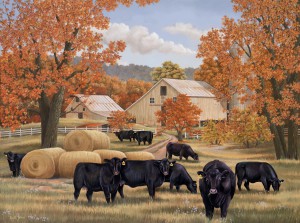 Autumn Angus | The setting for this painting was a farm I came across while driving the back roads of Western Iowa. I remember it was in the summer and very warm when I stopped to take a picture. It appeared to be abandoned and wanting for attention. In the final painting I cleaned it up a little, brightened it up with some fall color and brought it back to life with some nice fat cows still slick from summer grass. Some would call that "artistic license." |
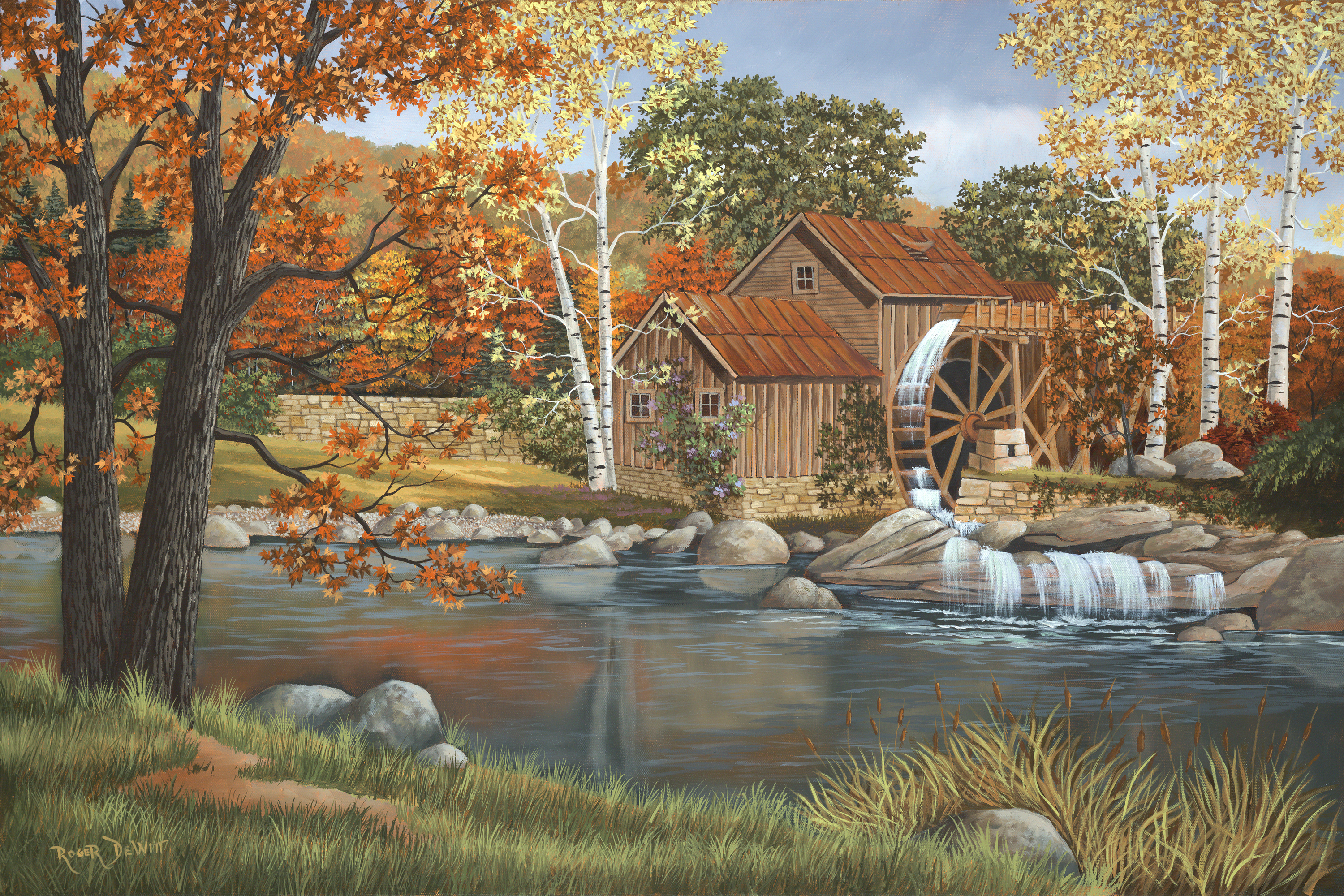 Autumn at the Mill | |
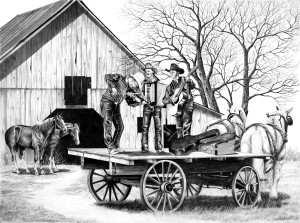 Band Practice | Music has always been a part of my life; and consequently, a reoccurring theme for my artwork. This pencil rendering depicts three young ranch hands stealing a little time to work up some new tunes for the upcoming Saturday dance in town. Having played for an untold number of dances myself, I can relate to the sounds and the feelings of the players on this wagon. I used my two nephews as models. I am the accordion player in the middle. |
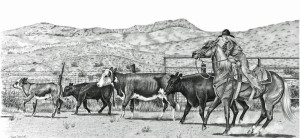 Casting for a Calf | I made this drawing as a reminder that there are women out there working ranches and farming side by side with the men and are just as capable of doing the jobs. Never underestimate a lady with a good horse, a rope in her hand, and common sense. |
 Complaining won't Help | |
 Concert in the Barn | My niece posed for me to do this painting. She is a delight to us all and such a talented and hard-working young lady. She plays both the piano and fiddle very well. Being such a perfectionist she doesn't like to practice in front of people. Animals, however, seldom offer critical commentary. |
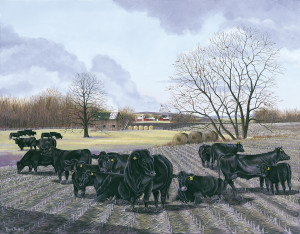 Cornfed Beef | This scene, once very common in the Illinois countryside, is becoming all too rare. It used to be that farms were smaller and much more diversified. Many farmers kept a few beef cows to produce calves. They were fattened out on corn and corn silage up in the barn lot during the fall and winter. After the corn was picked we would turn the old cows out on the stalk fields to eat the fodder and clean up all the ears of corn that the combine had missed. An old college professor of mine taught me that the average Midwest farmer makes money on cattle one year in seven. It only took me 14 years to prove him right. |
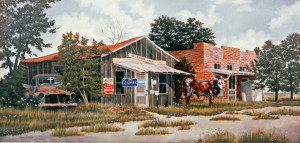 Cowtown | I found this little abandon town on the plains south of San Antonio, Texas. The road in and out was two tire tracks worn in the short grass prairie. I'm sure that the little cafe was a hangout for local ranchers and cowboys. Many a story was told and many a problem solved across the tables inside. Mother nature was now slowly reclaiming her. It makes me long for the days when I'd go to the little town of Dorchester on an errand and I'd always be able to strike up a visit with someone I knew at the local elevator or implement dealer- both now out of business. |
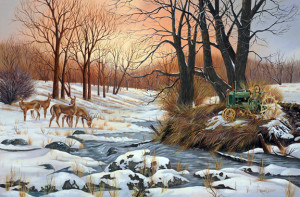 A Deere in Winter | If you are deer hunting and come across a green one, don't shoot it; only the brown ones. The green ones are very tough and hard to cook. |
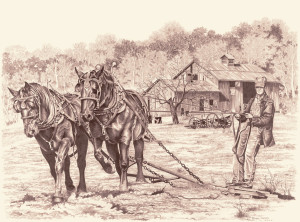 Diamond, Pet and Poppy | All the grandkids called my grandpa "Poppy. He was born in 1892 and farmed with horses for much of his life. His last team was a pair of Percheron mares he had raised named Diamond and Pet. He finally traded them off in 1952 to the local International Harvester dealer for a new Super C tractor. He always told us he cried that day. It was because of the stories he told me as a child about his horses that have inspired me to become a life-long horseman. |
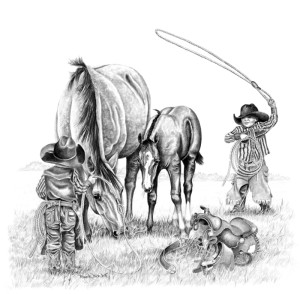 Double Trouble | This picture needs no explanation. When in the course of human events twin boys are born into a family of redneck cowboys, situations like this are bound to come up. |
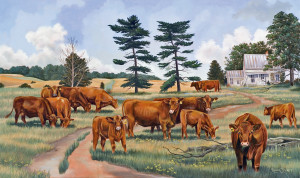 Fat Red Cows | These cows could be Red Polls, Red Angus, Shorthorn, or Limosin . Take your pick. Good cattle are good cattle, no matter the color or the breed. Our livestock just keep getting better as the generations pass. The old house shown here is all that is left but the memories of a family's home and farm a generation ago. It stands as a monument to a simpler way of life that is quickly being replaced by a much more complex world. |
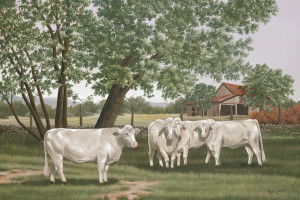 Fat White Cows | A farmer friend of mine farms along the west side of the river in Pike County. I have bought hay from him and his brother for many years. I've always been impressed with the quality of his cattle. They are Charolais and Charolais crossbreds. I painted this scene as a gift to him and his wife. |
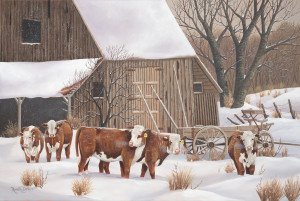 February Chill | It was late February and I was getting pretty tired of winter by the time I started this Painting. As I have gotten old, it sure seems like it has gotten a lot harder to keep warm outside. Before I finished we had a couple of really big drifting snows that made barn chores take twice as long as normal. I was getting sick of looking at snow, even on canvas. I finished it anyway thinking it might be nice to look at by July. |
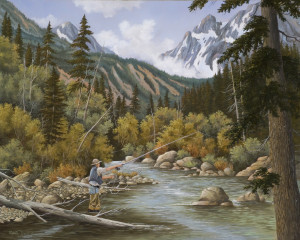 Fly Fishing | I have the most compassionate, wonderful and intelligent doctor anyone could ever wish for. He saved my life back in the nineties and has kept me going ever since. On top of that, he found the right doctors to save the life of my brother-in-law who would have died otherwise. We've had many interesting conversations over the years. In one of the talks, I found out that he loves to fly fish and has taken many trips to pursue his hobby. In gratitude, I presented him with this painting. I was elated when he told me he liked it so much that he hung it in his office where he could look at it every day and think about his next fishing trip. |
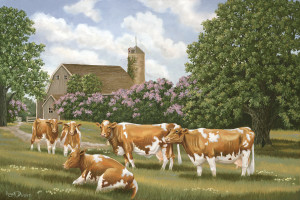 Full Bloom | I've always been partial to Guernseys when it comes to dairy cows. They have a very feminine motherly look and a golden color that reminds me of rich butter and cream. Maybe its because we had a family cow named Willamina; and she was a Guernsey. It was my job to milk her twice a day. When we got busy, I wasn't too concerned about the amount of milk she gave; but rather how long she could hold it! |
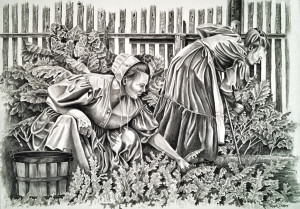 Gardeners | My grandma always had a big garden even after most of the family had left the nest. I remember watching her weed early in the morning while it was still cool. Her hoe had been sharpened so much its blade wasn't much wider than a butcher knife. Just about any vegetable you could think of was in that garden and most of them ended up in hundreds of clear Mason jars on long shelves in the cellar. My favorite helper job as a child was picking out those great big white potatoes as she flipped them out with her fork. |
 Grandpa to the Rescue | Starting back in the late twenties, tractors began replacing horses and mules at a rapid rate. As is always the case the younger generation was the driving force for adopting new technology. Grandpa was always slow to change...if he did at all. Thankfully, Grandpa's team would always start and rarely broke down in the middle of the field. |
 Hard Row to Hoe | Memories are a mixed bag for most of us. I think they tend to sort themselves out so that the happy, and pleasant ones tend to dominate the rest. While we shouldn't dwell on them, there are those sad and unpleasant remembrances that come to visit from time to time. I did this drawing to honor my mother who had to work very hard to raise and support two young children after my dad died when I was 12. |
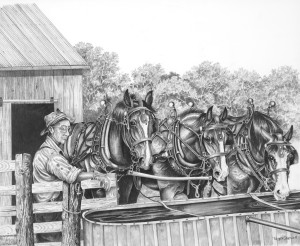 He Leadith Me | In my grandpa's world, as in mine, the livestock almost always got fed and cared for before he did. In the days of real horsepower, the relationship between a farmer and his horses were truly one of mutual benefit and respect. You take good care of them; and they would give their best even when the load got heavy and the going got tough. This is as true now as it was back then. |
 Herefords of the OXO | This OXO is a cattle ranch in the San Juan Mountain range of western Colorado. When we visited this ranch, I was in awe of the beautiful setting. The large peak is called Courthouse Rock" and has an elevation of over 14,000 feet. The ranch raises Hereford cattle of the highest quality. Sadly many of these beautiful historic western family ranches are being threatened by outside investors and commercial developments. (This family ranch was sold in 2014.) |
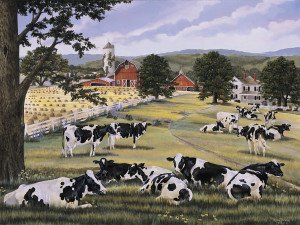 Holsteins | There is nothing more pleasing to a farm-boy's eye than a prosperous farm with contented cows and well-built and maintained buildings. At one time small dairy operations brought much needed cash to many Midwest farms. It took the whole family and a big one at that to get all the work done on a dairy farm. The farm was handed down through the generations and improvements were gradually made. It was a demanding life but a good one. |
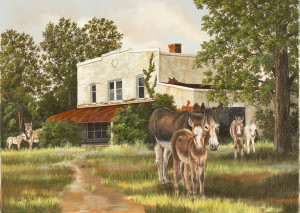 Home for Unwed Mothers | No, this is not a scene from south of the border. It is actually an old building somewhere along the Illinois river that used to be a store of some kind. It reminded me of an adobe type structure so I decided to add some burros to complete the idea. I needed some models so I went to the horse farm of a local lawyer where I have done a lot of business over the years. He had accumulated a large herd of miniature donkeys. He kept them in a large pasture and allowed them to multiply on their own, unchecked. What I remember most was when I looked through the camera to get a picture, I saw the whole herd standing close together looking straight at me with those long ears totally erect. It reminded me of a field of corn! |
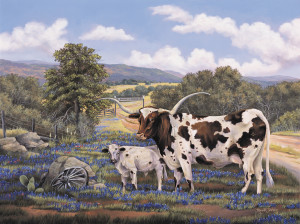 Horns in the Hills | This painting was done for a Texas man whom I've never had the pleasure of meeting. It depicts a pretty darn good Longhorn cow standing in the famous Blue Bonnets of the Texas Hill Country. For me it stirs remembrances of the saga of Charles Goodnight. Goodnight who is a relative of my wife was born on the Illinois prairie just a few miles from our farm. He rode bareback all the way to Texas at the tender age of nine. The rest, as they say, is history. Goodnight became a legendary Texas Ranger and pioneer in the history of the western trail drives and cattle ranching and is inseparable from the Longhorn cattle that started it all. (A fact, Lonesome Dove by Larry McMurtry is based on his lifes story.) |
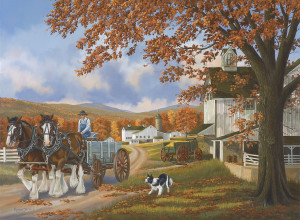 Lancaster Lane | The inspiration for this picture came from a farm road in Lancaster County, Pennsylvania. If you want to experience our farm heritage, well-preserved and thriving, this is one the best places to visit. The only problem is that it is so crowded with tourist traffic; it is almost impossible to drive by slowly enough to really enjoy the scenery. I took it back in time a few decades and the traffic just seemed to disappear. |
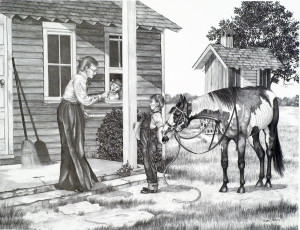 Late for School | Up the road from us is the "Old Red School House." There were hundreds of these wonderful one-room schools built to educate our young in the early 19th century and there are a few still in use today. As urbanization and "bigger is better took over, these schoolhouses were abandoned for larger more modern facilities. My wife's grandmother, who lived to be nearly 107, began her teaching career in 1918 and spent many years teaching in one-room schoolhouses-including this one. Because she was married, she was not allowed to teach in town. She told of driving horse and buggy or her Model A to school down a mud road we now call Illinois Route 16, stoking the stove, doing her own janitor work and then teaching all 8 grades. |
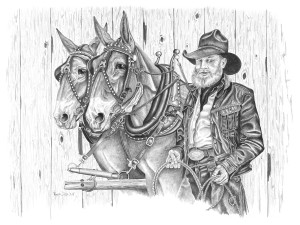 Maybelle, Maude and Marvin | Back in the days when horse power was really horse power, there were many old characters around like this fellow. In those times you were either a horseman or a mule man and the two just didn't mix. Kind of like a Ford or a Chevy man today. Marvin was definitely a mule Man! |
 Meeting at the Mill | Many bridges built before the late nineteenth century were covered with sides and a roof to protect the floor and structure underneath from the weather. This picture depicts the bridge and mill in Bridgeton, Indiana. It is a very small, sleepy little town well off the beaten path. In mid-October every year; it swells into a crowded mass of humanity as it is one of the main stops on the famous "Indiana Covered Bridge Festival." The old mill still operates but the bridge was burned to the ground by an arsonist shortly after I made this painting. Fortunately, the community rallied and rebuilt the bridge from locally cut timber using the original blueprints that were still filed away at the county court house. |
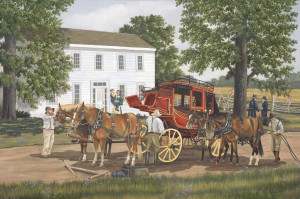 Middletown Stage Stop | This scene depicts a coach changing horses at the Middletown stage stop in Illinois. The old building still stands on the east side of the Middletown Square. It was built in the early 1830's. Middletown is a small, well-preserved little town about thirty-five miles north of Springfield, Illinois along the old stage route to Peoria. Before railroads came into the area, stage coaches carried the mail and passengers between major cities and towns. By law they were required to change horses every ten to twenty miles. Some stops had larger buildings where travelers could get a meal and overnight lodging. |
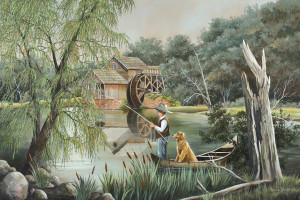 Mill Pond Fisherman | I painted this as a wedding gift for the young man who used to make the signature barn wood and barbed wire frames that I use on most of my original art. My wife and I went to school with his father and mother and have been friends with three generations of this farm family. |
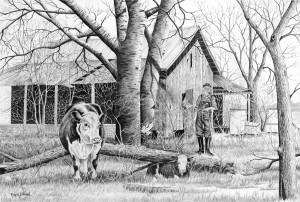 Missing Heifer | My grandpa had a small herd of beef cows that he kept after he retired and moved to a smaller place. I think helping him with these cows instilled in me a love for all livestock that has been a constant part of my life; and also greatly influenced my art work. I remember that if a cow was due to calf and didn't come up with the rest of the herd, we would anxiously head for the timber/pasture hunting for her, hoping we would find a new calf and no problems. |
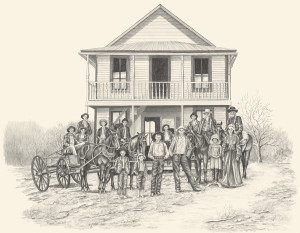 Missouri Kinfolks | This drawing was made for a man that lives down in the Ozark region of Southern Missouri. He found a tattered and faded photograph taken in 1904. It was of his grandfathers brand new building. It was a general county store like the ones so common throughout the country at that time. All the people in the picture just happened to be there when the photographer showed up. I re-created it for him in the form of a large graphite drawing--doing the best I could do given the hazy details. In the process of making this piece I uncovered a connection to my own history as my father's family lived in this same area, same time of Missouri. I am imagining they looked much the same as the people in this picture. |
 Moonlight Ride | The two youngsters in this picture are my nephew Ben, and his cousin Elizabeth. When I look at this picture, it reminded me of all the wonderful days I spent riding horses and growing up. It was during those years that I became acquainted with the girl who I grew to love and then marry. We will be celebrating our 43 year anniversary in 2016. |
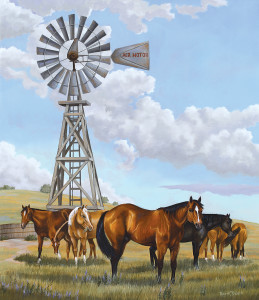 Nebraska | Windmills and stock tanks are as much a part of the western Nebraska landscape as are the sand hills and rolling short grass prairie. I came across this windmill as I was driving through that region. I was coming from a farm show where I had become acquainted with a retired rancher whose boys were now running the operation. He told me that on his ranch there were over 50 windmills that had to be checked and tended to on a regular basis. |
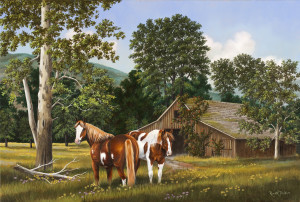 Old Friends | Through the years I've spent working with horses I've come to realize that although not quite the same as people, they do have memories and emotions. Perhaps these two old retirees or Old Friends have finally gotten back together after being separated for many years. |
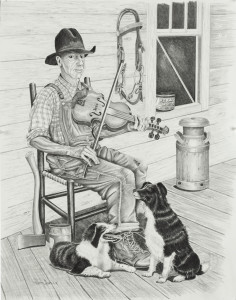 Old Jeff the Fiddler | The young man who first built all the frames for my artwork was named "Jeff". As a point of humor I did this drawing to let him know what he would look like as an "old" man like me. |
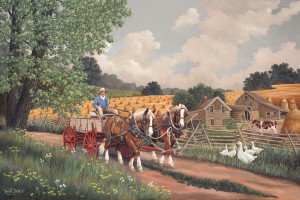 On the Old Peoria Road | In this painting I tried to imagine how the Illinois countryside might have looked back in the early part of the nineteenth century. There were still large stretches of open prairie and all roads were dirt wagon tracks and mostly following old Indian trails. Farms were just beginning to appear on the prairie. At that time they were small, subsistence-level affairs due to the fact that the dense roots of the prairie grasses were very difficult to break before the introduction of the steel moldboard plow. |
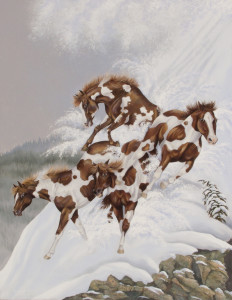 Over the Edge | My wife and I have enjoyed raising registered American Paint Horses for over 40 years. We still maintain a herd of retired broodmares and a couple of geldings. Therefore, I wanted this painting to show the beautiful color, contrast and emotion of this group of paints as they slide down a steep snowy slope. Don't worry they made it just fine; and no animals were harmed during the painting of this picture. |
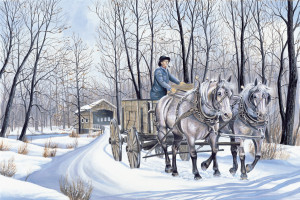 Over the River | My part of the Midwest used to be a mosaic of timber and open fields. Driving through the stillness of a stand of timber could be a welcome relieve from the open prairie if it was windy. The seasoned, old farmer in this painting is going to help a neighbor shuck the last of his late-planted cornfield which didn't make it to the crib before the first snowfall. |
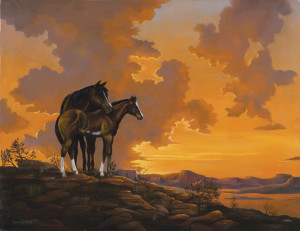 Painted Sunset | I have raised Paint horses for over 40 years. The passion of raising these animals coupled with my interest of the old west often allows me to imagine my mares and foals running free on the open prairies and in mountain valleys. This picture depicts one of those serene scenes a mare and her foal might enjoy as the last rays of sunlight leaves the mountain valley. |
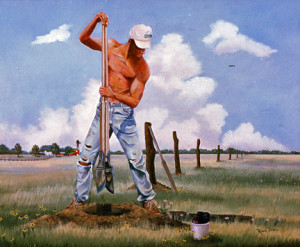 Post Hole Digger | Fence building and repair was a seemingly unending task on a mixed livestock farm in the Midwest. It's the kind of chore I really don't think I'll miss much if I ever get rid of my stock. In the Fall, we were too busy with harvest to get to the fencing. Likewise in the winter the ground was too frozen and in the Spring if the ground wasn't too wet, it was time to plant. That usually left us digging holes and stretching wire in the hottest part of the summer. The model for this painting was a young man that used to work for me. If you could once get him started, he was just like a machine that could run on bread and baloney and whatever was in the jug. |
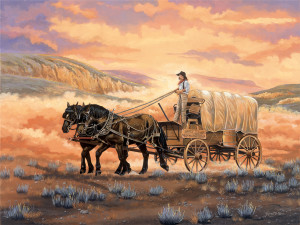 Pilgrim in the Valley | This painting was done for the sister of the young man driving the wagon. On one level this painting depicts a covered wagon being driven into a Western sunset. On a more spiritual level, it represents a particular young man's journey by wagon from Illinois to Utah a few years ago, his spiritual awakening and his untimely passing shortly thereafter. |
 Plum Tuckered | The models I used for this painting were my horseshoers daughter and granddaughter. It brings back many childhood memories for me as my family spent many weekends trail riding in Illinois and Missouri. There were many days when we would spend several hours riding in the woods. At the end of the day, all of the kids and horses were "Plum Tuckered". |
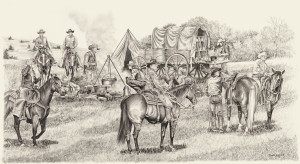 Prairie Cafe | There are still a few ranches--who in an effort to keep tradition alive--will round up cattle with a horseback crew and wagon. My wife's great, great, great Uncle Charles Goodnight was a celebrated, true western legend and among many other things invented the first wagon outfitted to cook and feed a large crew of cowhands. Named for its inventor it commonly became known as the "chuck wagon." Here the menu is beans, biscuits, beef and plenty of it. (Fact: Charles Goodnight was born near us in the small Illinois town of Bunker Hill. His father who died when he was young is buried in a cow pasture nearby. Charles and his new stepdad and siblings headed to Texas when he was nine.) |
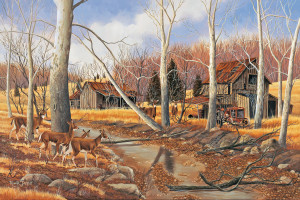 Reclaimed | This painting was based on one of my many childhood recollections. There was an old abandoned farmstead about a mile and a half north of our place in the middle of a large tact of timber. We used to ride our horses back there and spend hours exploring the buildings. There was still some interesting stuff left in the old house. There were also other old log buildings and horse drawn farm implements scattered around all concealed by 20+ years of growing trees and brush......very stimulating to the imagination of young minds. |
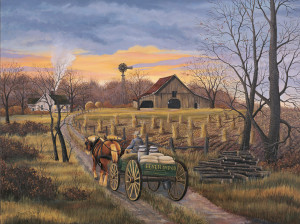 Returning Home | Grandpa used to say nothing was more welcome that a warm kitchen with supper waiting after a long trip to town with a team and wagon. Of course, the horses had to be unharnessed and fed first--then the cows probably needed to be milked before he could escape the cold. A trip to town, definitely, could cause chores to run a little late in Grandpa's day. |
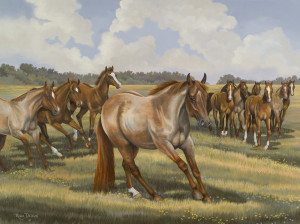 Running with Mr. Goodbar | Up the road is a large Quarter Horse breeding farm. I was asked to do a painting of their champion stallion Zippos Mr. Good Bar. This stallion has produced hundreds of award-winning offspring and is now in his thirties.) |
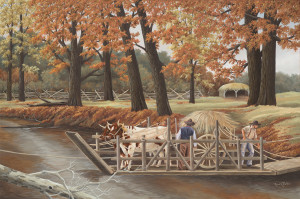 Salt River Ferry | Folks don't often think about the fact that during the early years of settlements there were few if any bridges. Rivers and streams had to be forded or crossed by ferry. Pedestrians, riders, wagons and stages all crossed this way. They were most often powered by hand using pulleys and ropes or pulled by horses or mules from the opposite bank. |
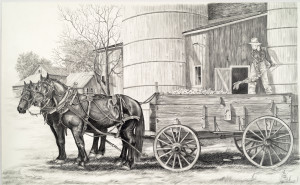 Scoopin Corn | Hard work started early in life on the farm. This boy is scooping off a load of hand-shucked ear corn into a granary in the barn. It likely would have been used for horse and hog feed. After dinner it would not have been uncommon for this boy and his father to shuck another load of corn before starting evening chores. The hardest part I found about scooping ear corn is getting down to the floor of the wagon where the shovel can slide more easily. |
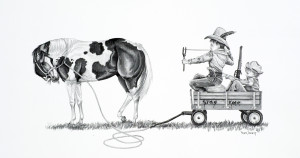 Sling Shot | When I first began getting serious about my artwork in 1984, my wife imparted to me a story about her older brother....... seems he had been given a brand spankin' new "Red Flyer" coaster wagon for his birthday. It was a great gift; but he soon got tired of pulling it around and decided it would be a much better idea if he took a hay rope and attached it to the family pony "Baldie" so he could do the work. He promptly did so; got into the wagon and chucked a big rock at the pony. My father-in-law said, "Doug was doing pretty good until the first turn......" |
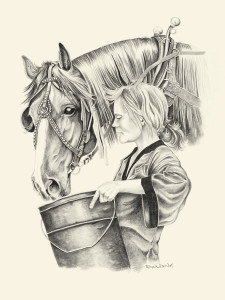 Small Kindness | There was a time when most of the heavy lifting in this country was done by the literal kind of horse power. Collectively horses, mules, and oxen provided the muscle to build this country. They were our indispensable partners for hundreds of year. We took care of them; and they took care of us.......kindness returned in kind. With that in mind, I'll pack their water anytime. |
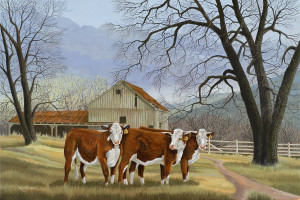 Spring Heifers | I painted this just as the first leaves of spring were beginning to add a little touch of green to the landscape. These white-faced heifers are to remind me of the kind my family and most of our neighbors raised back when I was a youngster. You don't see many anymore as you drive through the country. This cattle shed is one of many no longer in use not far from where I live. |
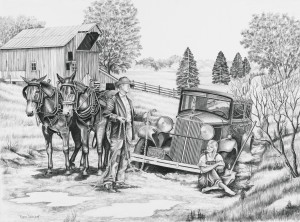 Stuck | This scene was probably repeated many times before the roads in the country were paved. One of the stories my grandpa used to tell was of an ornery, old neighbor who used to block up the culvert under the road in front of his place when it rained. He kept the mules ready in the barn so he could pull unsuspecting city folks out for "four bits" a piece. |
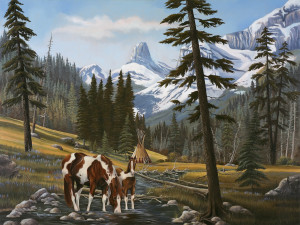 Summer in the Sierra | This painting was done strictly to please the eye and mind -- especially my own. The location depicted is no place in particular--just some high mountain valley lost in time--some place I'd like to find someday and stay awhile. |
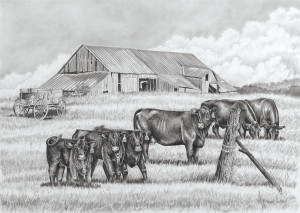 Summer of Aught Ten | Wisconsin still has quite a few classic old barns left. I found this one in the southeastern part of the state. It was a large old structure with interesting lines. The wood siding hadnt been painted in many years and had a beautiful grey patina from years of weathering. It was beginning to slump and will eventually surrender to the earth on which it stands. |
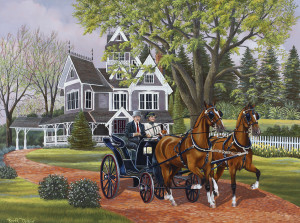 Sunday Drive | I don't remember where I saw this grand old Victorian home but it made an impression on me. I took it back in time and imagined it belonged to a well-to-do couple that could take a fine carriage and team of harness horses to parade around town on a Sunday afternoon. |
 Takin Out the Kinks | The setting for this drawing is somewhere in the southwest where corrals and round pens are sometimes made of mesquite wood using wattle construction. The horseman is "ponying" a young two-year-old, getting him used to the squeak of the leather and the flopping of the stirrups from the saddle on his back. This will help take the spook out of him before his first ride. Notice the cowboy is riding a well-schooled, experienced horse that won't get rattled by the antics of the younger horse. |
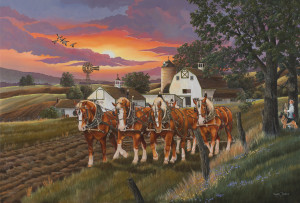 The Land Remembers | The land itself is the primary source of wealth in the Midwest. I painted this picture to illustrate the prosperity the land has provided for this Iowa farm. It is the dawn of a new day and the six horse hitch of strong Belgians is already in the field finishing the Spring plowing. |
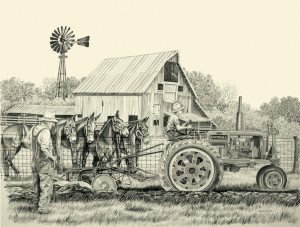 The Skeptics | Somewhere in the farthest reaches of my memory, I can recall an ancient, rusted Farmall F20 quietly sleeping--half hidden in a bed of giant rag weeds behind our barn. At one time it represented the cutting edge of farming technology. This drawing represents the glory days of its youth and the skepticism of those it was destined to replace. The passing of an era, reduced as best I could to a single image. |
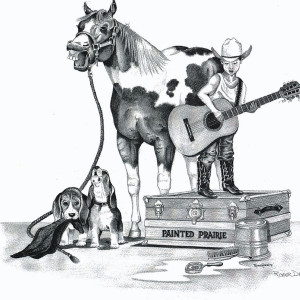 Three Part Harmony | In my past life I spent many weekends camping and trail riding with my family and a large group of friends. As a youngster, I had formal training playing the accordion but soon found playing the guitar around the campfire was far easier. All my extended family tolerated my singing and playing--often comparing me to Alfalfa, from the Little Rascals show. Fortunately, after much practicing my singing and playing has improved. |
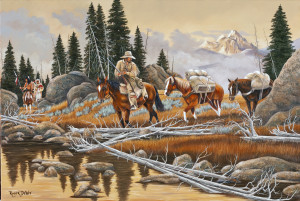 Unexpected Encounter | Fur trappers in the uncivilized west of the early nineteenth century lived a dangerous and often short life. I painted this picture for my brother-in-law who likes black powder and mountain men lore. This unsuspecting trapper is about to ride into a very tense situation that probably will not end well. |
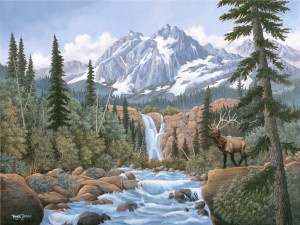 Valley of the Falling Waters | This oil painting was done for one of my favorite young couples. I had been the best man at his parents wedding and have watched the boy grow into a fine man and father. |
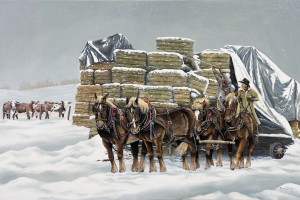 When Chores Get Chilly | I guess, I've been doing chores since I was old enough to lift a bucket. A good stockman takes care of his livestock before himself--twice a day, seven days a week, 52 weeks a year. Although the winter winds can sting you to tears, feeding the stock on a quiet winter day surrounded by softly falling snow can be very pleasant indeed. As depicted in this picture, out west where the climate is dry, baled hay can be stacked outside and some ranches still feed with a team and wagon or sled. |
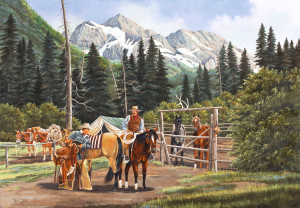 Wranglers in the Gros Venure | This painting shows our camp in the "Wind River Range" of the Rocky Mountains--located about thirty miles outside of Jackson Hole, Wyoming. We rode out in a different direction each day into some fantastic scenery often riding above the tree line. This was a trip we will never forget. |




































































